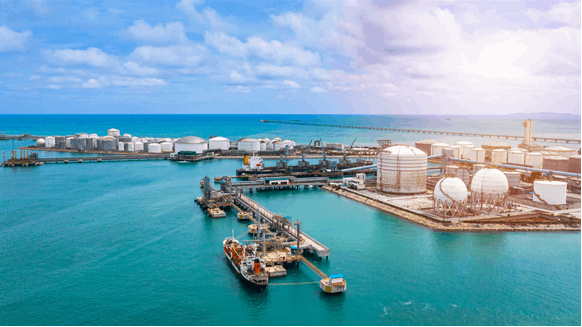Two LNG Terminals Completed in Philippines

Two liquefied natural gas (LNG) projects have wrapped up construction in the Philippines, opening up importation to meet growing energy demand in Southeast Asia’s second most populous country.
The facility by AG&P International Pte. Ltd. and Linseed Field Power Corp. in Batangas Bay has already started supplying a power plant in Batangas province while the other terminal owned by FGEN LNG Corp. is set to receive its first LNG cargo later this year, according to a press release by the Department of Energy (DOE) Friday.
The LNG fed to the Ilijan combined cycle plant enabled the power station to resume supply to the electricity grid Thursday, the department said. The 1,200-megawatt mill, owned by a Philippine subsidiary of Korea Electric Power Corp. and operated by Filipino conglomerate San Miguel Corp., ceased operation June 2022 after the fuel supply stopped from the depleting Malampaya gas field.
“All these developments are positive signals reflecting the continuous interest of the private sector in investing in critical infrastructures that will allow the country to import and utilize imported LNG and complement the available gas from the Malampaya reservoir to meet the country's growing energy demand”, Friday’s announcement noted.
In April the country received its first-ever LNG supply from abroad, as announced by AG&P. The Singapore-based AG&P signed last year a 15-year deal with the Abu Dhabi National Oil Co. to supply the former with LNG, as announced by AG&P February 23, 2022.
The entry of LNG diversifies the Philippines’ energy mix, providing “flexibility” in meeting energy needs, the DOE said.
Energy Transition
The department added, “This flexibility also enables our push to further develop intermittent renewable energy technologies such as solar and wind”.
The DOE has projected an annual growth rate in peak power demand of around seven percent from 2020 to 2040. To meet this, the nation of over 113 million people must raise installed capacity by more than five times from 22,317 MW in 2019 to 114,601 MW in 2040, according to the agency’s “Power Development Plan 2020-2040”.
Coal has historically been the Philippines’ biggest power source, accounting for 62,052 gigawatt hours (GWh) of the national gross power generation of 106,115 GWh in 2021, based on the department’s latest available data, released June 20, 2022. Contribution from natural gas that year at 18,675 GWh was ahead of oil at 1,616 GWh but behind renewables at 23,771 GWh.
However the department has imposed a moratorium effective October 2020 on the issuance of licenses for coal-fired plants in support of the transition to clean energy. The government in 2021 also joined the COP26 global pledge to phase out coal power by the 2040s.
Moreover, output from the Malampaya field, the only active of just two commercial natural gas discoveries on the islands, has consistently fallen since 2019 from 155.49 billion standard cubic feet (Bscf) that year to 113.61 Bscf in 2022, according to a DOE update published February 15. Shell PLC late last year completed the sale of its entire 45 percent operating stake in the field to local company Prime Infrastructure Capital Inc.
To support supply, the DOE has approved the development of seven LNG terminals, including the two now completed, to bring in LNG from overseas.
To contact the author, email jov.onsat@rigzone.com
What do you think? We’d love to hear from you, join the conversation on the
Rigzone Energy Network.
The Rigzone Energy Network is a new social experience created for you and all energy professionals to Speak Up about our industry, share knowledge, connect with peers and industry insiders and engage in a professional community that will empower your career in energy.
- Carbon Capture, CO2 Removal to Play Key Decarbonization Role: S&P Global
- EU Posts 2.8 Percent Lower Fossil Fuel CO2 Emissions for 2022
- USA Buying 6MM Barrels to Refill SPR
- Generative AI Will Have Profound Impact Across Sectors
- UK Government Announces New Oil and Gas Tax Changes
- Aker BP Completes Record-Breaking Drill for North Sea Discovery
- North Dakota Tribe Buys Enbridge Pipeline
- Short Sellers Refuse to be Cowed
- Iran Says There Are No Negotiations with USA Over Nuclear Deal
- Shell CEO's New Strategy Sees Long Term Future for Natural Gas
- Saudis Remind Global Oil Market Who is King
- USA EIA Hikes Up 2023 and 2024 Brent Oil Price Forecasts
- Debt Ceiling Deal Becomes Law
- Two Main Forces Have Come Together to Pull Down Commodity Prices
- Biden Urged to Demand Climate Emergency as Smoke Chokes Washington
- Macquarie Group Reveals Oil Market Outlook
- Americas Exploration Heats Up
- UK Offshore Energy Calls for Labour Party Meet
- Oil Down as Demand Concerns Supercede Saudi Cuts
- Aker BP's 1.07 Bboe North Sea Projects Get Parliament Nod
- Which Generation Is Most in Demand in Oil, Gas Right Now?
- Who Is the Most Prolific Private Oil and Gas Producer in the USA?
- Is There a Danger That Oil and Gas Runs out of Financing?
- What Will World Oil Demand Be in 2023?
- BMI Projects Gasoline Price Through to 2026
- North America Rig Count Reduction Rumbles On
- Saudis Remind Global Oil Market Who is King
- What New Oil and Gas Jobs Will Exist in the Future?
- What Does a 2023 USA Recession Mean for Oil and Gas in the Country?
- USA Oil and Gas Supported Nearly 11MM Jobs


